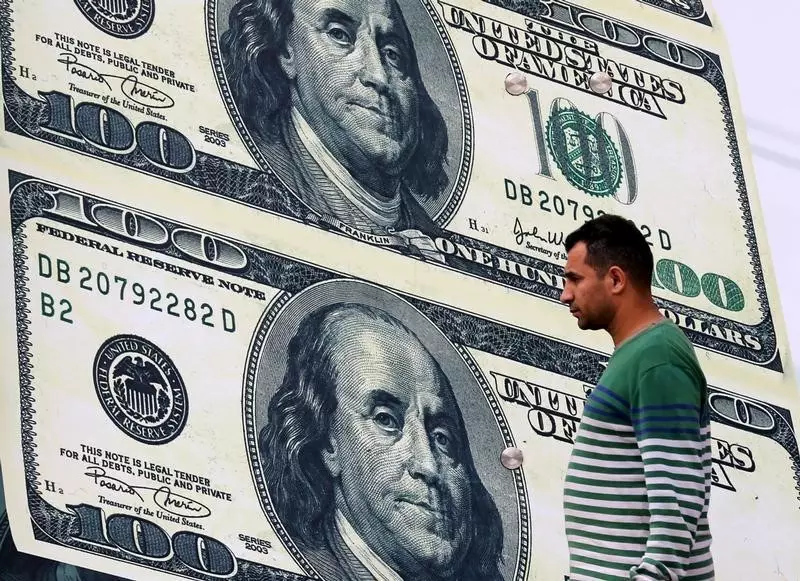The foreign exchange market is notoriously sensitive to economic data releases, and recent indicators have caused notable fluctuations in the value of major currencies. The US dollar has shown signs of stabilization following a period of decline driven by diminishing inflation data. Meanwhile, the British pound experienced a downturn in response to lackluster growth figures, illustrating the interplay between economic performance and currency valuations.
After experiencing three consecutive days of losses, the US dollar found a semblance of stability as it rebounded slightly. This upward movement, as measured by the Dollar Index which gauges the greenback against a basket of six rival currencies, reflects a broader sentiment within the markets regarding the initial implications of a cooling inflation environment. Analysts have reiterated that the decline in inflation has set the stage for potentially slower policy changes by the Federal Reserve, despite the dollar’s recent strength.
Key reports, particularly the Consumer Price Index (CPI) and producer price indexes, have revealed a benign inflation landscape in the United States. The CPI figures in December came in below expectations, contributing to a narrative of moderating inflation which could hinder aggressive monetary tightening from the Federal Reserve. Despite this, analysts remain cautious. ING’s commentary underscores that while sub-three percent inflation offers a breath of relief, persistent pressures could complicate any anticipated easing of monetary policy in the near future.
As the market digests the economic implications of Donald Trump’s impending inauguration, the atmosphere is thick with anticipation regarding his proposed economic policies, particularly around tariffs. The looming uncertainty regarding these policies has led to fluctuating sentiments in forex markets, particularly concerning the dollar’s valuation. In light of Trump’s administration, expectations are gathering around currency stability amidst potential trade tensions which could exacerbate inflation trends.
Amidst this backdrop, market watchers are keen on Scott Bessent’s upcoming confirmation hearing for the role of US Treasury Secretary. Considered a pivotal figure, Bessent’s responses on currency stability and fiscal policy will likely shape expectations in the forex arena. Analysts predict he will maintain the strong dollar narrative, which could further bolster confidence in the dollar’s strength.
Turning to the UK, the British pound has shown weakness, declining notably against the dollar. Recent data revealing a slight growth of 0.1% in the British economy has not met the expectations set by forecasters, igniting fears about the trajectory of economic recovery post-pandemic. The Bank of England’s anticipated rate cuts have further compounded pressure on the pound, leading to a diminished outlook for the currency in the coming months.
Forecasts indicating potential rate cuts signify that the Bank of England is grappling with the complex realities of returning to pre-pandemic growth levels. The market seems to have “priced in” these cuts, suggesting that investors are bracing for a slow recovery that may necessitate prolonged accommodative monetary policy, which could continue to weigh on the sterling.
The euro has not escaped the wave of currency volatility either. A slight dip in the EUR/USD exchange rate highlights concerns regarding the eurozone’s economic performance. Recent inflation figures from Germany and Italy suggest persistent price stability, providing context for the European Central Bank’s looming decisions. Expectations are forming around substantial rate cuts in 2025, potentially exceeding those anticipated by the Federal Reserve, reflecting a troubling outlook for the euro amid sluggish economic growth and leadership challenges within the region.
The response of the EUR/USD exchange rate to recent US CPI data showcases the delicate balance between competitive currency valuations and economic fundamentals in the eurozone. ING’s analysis of the euro’s performance post-CPI report illustrates a reluctance among traders to embrace a bullish stance on the euro, revealing skepticism about the eurozone’s resilience compared to its US counterpart.
Asian Market Insights
In Asia, specific currency pairs have also been affected by the broader global economic narrative. The Japanese yen has rallied, underpinned by signals from the Bank of Japan regarding potential shifts in interest rate policy. Governor Kazuo Ueda’s indications of a forthcoming interest rate rise have spurred confidence in the yen, showcasing how domestic fiscal policies can significantly influence foreign exchange dynamics.
At the same time, the Chinese yuan remained relatively stable, trapped at a 16-month high against the dollar. The anticipation of forthcoming domestic economic data underscores the complexity of decision-making in forex as traders gear up for critical GDP reports that could influence market direction.
The recent alignments within the forex market exemplify how economic indicators, political developments, and central bank policies converge to affect currency movements. As investors navigate these waters, it is essential to remain vigilant to both domestic and international economic signals that will undoubtedly shape the future landscape of currency valuations.

